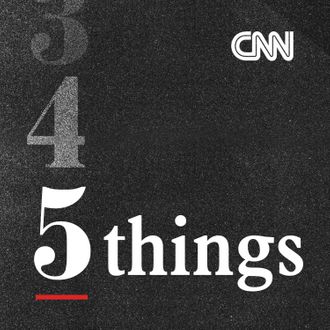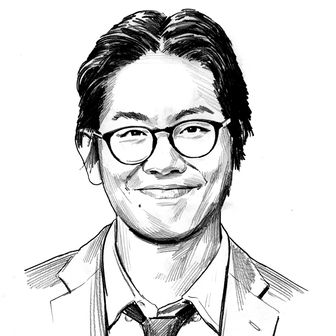
CNN has been wrapped up in a wild assortment of headlines lately — the WarnerMedia-Discovery spinoff merger! The Cuomo scandal! Streaming service? Cicadas! — but the company’s most important storyline remains pretty much the same: its primary cable-oriented business model continues to be on a secular decline, and now that the Trump bump is over, there’s not much to paper over that fact.
Given that existential trend, it’s worth paying some close attention to what the organization is doing by way of experimenting with new content forms and business models beyond its core cable operation. I’m particularly interested, of course, in CNN’s growing adventures in podcasting, which popped up with unexpected prominence in the earlier days of the pandemic, when its contribution to the cohort of pop-up pandemic pods, Coronavirus: Fact vs. Fiction, rocketed up the podcast charts and stayed there for an extended stretch of months.
Short and succinct, Coronavirus: Fact vs. Fiction took a relatively simple approach to covering a chaotic time: build a show around the subject matter expert, in this case Dr. Sanjay Gupta, and have him run a short ten-minute-or-so episode every day unpacking a different thread of the rapidly evolving pandemic. The end product was notably comforting in its reliable presence, and it developed a considerable following as a result.
“It was, honestly, a podcast we hadn’t anticipated,” said Courtney Coupe, CNN’s SVP of Digital Productions, when we connected in late April to discuss where the company’s podcasting efforts go from here. As Coupe recalls, the show came together very quickly over the course of a weekend. At that moment, the company’s podcast team was still being assembled, with its executive producer, Megan Marcus, having just been hired a few months prior.
The digital team had also just secured a firm commitment from management that CNN was formally getting into the on-demand audio business. Not that there hadn’t been any prior activity, of course. The company had already published a number of podcasts for years, mostly a mix of interview shows, like Brian Stelter’s Reliable Sources podcast, and cross-media repackages of its television content. According to Coupe, the shift that’s happening is one of intentionality, describing how those previous efforts were mostly individual teams throughout the organization launching their own shows and side projects without a unifying strategy. The focus now is to build new shows on a framework that ties everything together.
A good example of this emerging integrated approach can be found with 5 Things, which started out as a popular newsletter product that CNN has since adapted for podcasting and smart speakers. (It was also converted into a television segment.) You can discern a replication of Coronavirus: Fact vs. Fiction’s merits in terms of its structure: The 5 Things podcast is a bite-sized daily audio product that delivers the five key headlines of the day, perfect for a quick podcatcher download or a response through an Alexa query. That adaptation effort seems to be highly successful. According to Digiday, the 5 Things podcast, which drops morning and evening editions, accounts for 43% of CNN Audio’s total podcast downloads, and there appear to be plans for the company to even roll out international editions of the product. (5 Things is additionally available in Spanish.)
The company is also said to be hiring a dedicated team of 10 people to support the effort. “We’re really focused on the 5 Things podcast and building out another team dedicated to that and additional short-form content,” Coupe told me. “If you think about how audiences relate to CNN, it’s almost Pavlovian. When news breaks, they turn on the television. We want to create that with other platforms.”
Though CNN Audio’s portfolio contains a few other standard news and politics shows, the two aforementioned daily short-form podcasts, along with the Pavlovian orientation they represent, offer the best lens to read the current state of CNN Audio’s audience metrics. The division’s podcast downloads as a whole are up by a whopping 91% since 2019, driven in large part by the dramatic increase in publishing volume as facilitated by Coronavirus: Fact vs. Fiction and 5 Things.
Having established that foundation of listenership, the company is now working to press harder into the medium. After 14 months and over 300 episodes, Coronavirus: Fact vs Fiction — still said to be CNN’s best-performing podcast in terms of downloads — was converted into a new show called Chasing Life in early May, which retains the feed (along with its subscribers) and its primary host. The switch is thematically in keeping with the shifting coronavirus picture and gives Dr. Gupta the opportunity to further his coverage through another lens: by exploring how people can readjust to life after the pandemic with a specific focus on the science behind health, happiness, and fulfillment. Chasing Life does involve a structural shift, however, as the show sheds its predecessor’s daily publishing schedule for a weekly one.
Elsewhere, the CNN Audio team has also started pressing into more evergreen content. Its first release in this area was Behind the Desk, which served as a companion podcast to the CNN Original documentary series The Story of Late Night. For what it’s worth, companion podcasts often strike me as a fairly unexciting frontier of content strategy, but I do want to take a beat to point out that there’s a tremendous amount of potential around CNN and audio documentaries more generally. Personally speaking, I’ve been plugged out of CNN’s live news programming since the elections — like many other people, I reckon — but I continue to engage through its various documentary and docuseries projects, which I’ve always found to be CNN at its most interesting.
The channel was, of course, the home of Anthony Bourdain: Parts Unknown, and it continues to produce a suite of really high-quality nonfiction television programs — including W. Kamau Bell’s United Shades of America, the various decades-oriented documentary series (The Eighties, The Nineties, etc.), hunky Stanley Tucci running around Italy gloriously stuffing his face — that don’t feel as commoditized and anonymous as they would, say, if they were produced and distributed by Netflix. Point being: I think there’s considerable room here for CNN Films and Original Series, the divisions that oversee these docuseries, to do some really interesting stuff with CNN Audio, and when I asked Coupe if there’s any deeper collaboration going on, she tells me that the two teams are communicating, and that they’re finding the best places to work together.
A quick word on revenue, because this is a trade newsletter. At this writing, the audio division is principally monetized through advertising. The Digiday writeup notes that this mostly takes the form of custom ads that CNN produces for its audio advertisers, though they are apparently running limited tests around programmatic audio advertising. But there are also some experiments on this front. Most notably, the division has an upcoming show with Don Lemon and Chris Cuomo called The Handoff that appears to be exclusive to the “CNN Channel” that will be built using the Apple Podcasts Subscription product — that is, whenever Apple finally rolls that out. We’ll see what comes of that.
I’m intrigued by CNN Audio and am genuinely curious to see if it meaningfully contributes to the reshaping of CNN’s prospects over the long term. For now, though, there’s still fundamental work to be done, as the company endeavors to broaden out its brand from just being thought about as a cable news company with some digital trimmings to something that’s quite more than that. “Audiences don’t necessarily know that CNN is in the audio game just yet,” said Coupe. “So what we’re aiming for is to be top of mind and to be one of the biggest brands in the audio space the same way we are in television and in digital. That’s what our goal is right now.”
Apple Delays Podcast Subscriptions Rollout for Publishers
The company made the announcement last Friday through a newsletter sent out to creators using its podcast-distribution tools.
The notice read:
We’re writing to provide an update on the availability of Apple Podcasts Subscriptions and channels. We’ve been delighted by the response to last month’s announcement and it’s exciting to see the hundreds of new subscriptions and channels submitted from creators across the globe every day.
To ensure we are delivering the best experience for creators and listeners, Apple Podcasts Subscriptions and channels will now launch in June. We will communicate further updates on availability, and best practices to help you prepare your subscriptions and channels, through this newsletter.
Over the last few weeks, some creators have experienced delays in the availability of their content and access to Apple Podcasts Connect. We’ve addressed these disruptions and encourage creators experiencing any issues to contact us.
We’ve also heard from listeners and made adjustments based on their feedback with iOS 14.6, which was released on Monday. We will introduce additional enhancements to Library in the coming weeks.
An inauspicious development for what had already been an inauspicious string of weeks for Apple Podcasts, whose platforms appear to have seen a sharp uptick in bugs and usability problems that was seemingly tethered to the rollout of iOS 14.5 and updates to the Apple Podcasts Connect portal in late April.
Apple’s podcast-subscription tools, which some consider paradigm shifting for the ecosystem given Apple’s status as the incumbent distribution platform, was originally scheduled to launch for publishers in its entirety in the latter half of May, and last week’s iOS 14.6 update had included an adjustment to the Apple Podcast app allowing it to support the new feature.
If this product push is the big deal that it’s being positioned to be, the shakiness of this rollout, combined with the recent wobbliness of its back end, does not bode well. Despite its historically dominant position, Apple Podcasts has never been the most technically robust, and the platform’s status feels unsettling in its fragility, perhaps more so than ever, at this point in time.
Selected Notes
➽ Podchaser, the podcast-database company, has launched a podcast API meant to help developers “access unique data and engagement features to build powerful new products.” More details here.
➽ Monitoring this story: Hold Still, Vincent, a star-studded table-read podcast about the 1982 murder of Vincent Chin, has come under criticism for not contacting the Chin estate or Helen Zia, a leading figure in the “Justice for Vincent Chin” campaign, over the course of production. A-Major, the Valence-Media-funded studio that produced the series with QCODE, Automatik, M88, and Writ Large, issued an apology over the weekend and stated that they are disabling the podcast until further notice — though it seems to still be available on Spotify and third-party podcast apps. Hit Rafu Shimpo and the Reappropriate blog for more detail.
➽ Spotted in the wild: a job posting stating that Spotify is “launching a new daily show based in Los Angeles… [that] will mix music and talk segments, in a modern take on afternoon drivetime radio. This production will work under the direction of Gimlet’s New Formats team.” Speaking of which, I gotta find a way to get my hands on a Car Thing.
➽ While we’re on Spotify: I didn’t know that the Slack group for Gimlet Members — launched years ago, back when Gimlet was still a startup in search of robust business models and had a strong sense of a follower community — was still operational, but no longer. The company apparently shut down the Slack this morning, to the dismay of the forty-some people who had continued using it.
➽ CBC Podcasts and the BBC World Service have launched a joint podcast-commissioning effort, and they’re currently seeking proposals for “a factual narrative podcast, unique in story and treatment, told over 8-10 episodes, which will be presented as a major joint series in 2022.” Pitches are accepted until late June, and the results will be announced at the end of September. The IP ownership situation is unclear to me in the current available materials, so be sure to check on that before you send in your pitches. Here’s the link.
➽ Speaking of the CBC, there’s a rather small subplot going on involving that podcast operation I’m fascinated with: The division recently released a documentary series called A Death In Cryptoland that takes on the exact same subject as Aaron Lammer’s Exit Scam, which beat them to release by about two weeks. The footrace itself is interesting to me, but more interesting are the differences between approaches of the two productions, one a national broadcaster, the other a small independent team. May the best (told) scam win.
➽ “I feel like I can walk into a party saying, ‘Oh, yeah, I brought the Topo Chico,’” says area podcast man.
The Wild World of Audio Internships
By Skye Pillsbury
After Melissa Lent graduated from CUNY Hunter College with a double major in media studies and English, she was eager to land a job in journalism — ideally, audio journalism. There was reason to feel optimistic about her chances: During Lent’s time as an undergrad, she’d managed to pack in over five internships (including one with WNYC’s podcast Nancy), land two fellowships, and create her own four-part podcast about Gen-Z anxiety.
But despite these accomplishments, looking for an entry-level position proved challenging. “It was pretty daunting, to be honest,” said Lent. “You’re thinking about an entry-level job and a lot of [the hiring companies] want you to already have a year or two of experience. I don’t have that, but I know that I’m able to do the work.” She eventually landed a part-time position as a lecturer in the media studies department at Hunter College, but she still had her eye on actually working in audio.
It was during this period that Lent came across a post on an audio listserv from Laura Joyce Davis, the host of independent podcast Shelter in Place. Davis and her husband Nate were offering a ten-hour-per-week “apprenticeship program… designed to mentor women who are interested in becoming podcasters, audio editors, and creative entrepreneurs.”
It sounded great. There was only one catch: Apprentices would not be financially compensated for their work.
“I was hesitant to do it when I learned that it was unpaid,” Lent told me last month. “Especially as a young woman of color who is navigating this industry, I want to make sure that I’m signing up for opportunities that are the best for me and getting paid for my work.”
But the reality was that she didn’t have any paid options, aside from a few freelance gigs and her part-time lecturer position. She decided to apply and, along with a few others, was accepted. Together, they made up the first apprentice cohort at Shelter in Place.
Earlier this year, Lent completed the program and says positive things about the experience. “I created a [project-management] role for myself, which is now being offered as an option for future apprentices.” As part of that new role, she “onboarded the team to a new project-management tool” and created a series of guides for future interns to use, which covered everything from assistant production work to social media.
“It was exciting for me to create those systems,” she recalls. “First of all, because I love being organized. But second, because then other apprentices would already have a frame of reference going in, which would make the process easier for them.”
She was also given the chance to pitch a story idea to the team (which she eventually helped produce as its own episode of the show) and said that Davis and her husband made speaking with the group about their goals and ambitions a regular part of the curriculum.
As great as this sounds though, unpaid work in any capacity — even a ten-hour-per-week apprenticeship with a well-intentioned boss — raises a host of thorny issues.
According to the U.S. Department of Labor, employers should consider a seven-point test, when determining whether or not an internship should be paid. This guidance — which has been used in court cases involving unpaid interns — essentially boils down to whether the position mostly benefits the employer or the intern. If it mostly benefits the employer, the intern should be paid, and conversely, if it benefits the intern, the intern doesn’t need to be paid.
However helpful this guidance may be in court, in real life, it’s a bit squishy. In the case of Shelter in Place, how does one approach assessing whether the show benefits more than its apprentices, or the other way around?
Regardless of governmental guidance, one of the more troublesome issues connected to unpaid internships in the U.S. is that it excludes applicants who can’t afford to work for free. In the view of many, this inequity perpetuates the socioeconomic — and ultimately, classist and racist — hierarchies we see at the top of countless companies in this country. Further, when underprivileged groups are denied upward mobility within the media industry, they not only lose the work, but also the chance to bring narratives specific to their experience into public view.
I reached out to Davis and asked what she would say to an applicant who really wanted the position but simply couldn’t afford to work without pay. She took a moment to gather her thoughts, but she eventually posited that “if [an applicant] is coming at it from a situation of, like, ‘I’ve only got ten hours, and I really have to make money to make ends meet,’ then I just don’t know that they will get very much out of it, if they’re already feeling so stretched thin in life.”
In researching this story, I didn’t come across any evidence that would suggest that if a person lacks funds, they’ll get less out of an opportunity. In fact, I would argue that the opposite outcome might be more likely — that the hungrier you are, the harder you might work in order to improve your circumstances.
In any event, I’ve seen enough to suggest those able to afford unpaid internships are often viewed by hiring managers and influential decision makers as the hungriest. During a 2019 Third Coast panel discussion titled All Workplaces Are Workplaces About Power, Carla Murphy, a journalism educator (and one of the session’s panelists), said she believes this point of view is pervasive within the media industry. “A ‘good journalist’ has been used to define someone who’s able to ‘stick it through,’” said Murphy. “The person who’s able to work those unpaid jobs — they’re valorized. [Imitating a hiring manager:] ‘Oh I know that you really want it because you had four unpaid internships.’ Exploitation is baked into the system.”
Unpaid audio internships are nothing new. Up until 2011, NPR only paid their summer interns, rather than their fall and spring cohorts. (Today, all NPR interns are paid $15 per hour across the board.) Over the course of my reporting, I spoke with a number of people who couldn’t afford an unpaid internship back then and applied to NPR’s paid summer program instead. One of those people was John Asante, now a senior managing producer at Pineapple Street Studios. He was offered and accepted the summer internship but recalls that “it was still tough. I literally had just enough money between getting paid [by NPR] and money I had received from my family for graduation to actually move to [Washington D.C.] to do the internship. I don’t think I would’ve been able to do it, had I not had a little bit of support.”
Today, Asante is part of a team at Pineapple that — in addition to its regular work making podcasts — actively mentors the firm’s apprentices and interns. (Pineapple pays $20 per hour to the former, who are expected to have some experience, and the same amount to the latter, who arrive with little to no experience.) Pineapple began paying their interns and apprentices right out of the gate; in fact, I was told that founders Jenna Weiss-Berman and Max Linsky paid those employees before they started paying themselves.
Erin Kelly, Pineapple’s production operations manager, said that interns and apprentices work closely with lead producers, who include them in all elements of audio production, from story development and cutting tape to archival licensing and legal review. Interns and apprentices also get multiple opportunities to learn about each role within the organization by talking directly to the people who hold those positions. By the end of the experience, the participants complete an audio sizzle reel for one of Pineapple’s podcasts that they can add to their CV. “We see this as a way for them to have something tangible to share and add to their resume for future jobs. We want them to leave feeling prepared,” said Asante.
Another podcast studio, Dustlight Productions, offers an apprenticeship program that carries a similar philosophy. “The main responsibility [of our apprentices] is to learn as much as possible,” Rachael Garcia, Dustlight’s development and operations coordinator, told me. “We are firmly against giving them busy work.”
Garcia also clarified that despite the title “apprentice,” Dustlight’s entire program is designed for people relatively new to the medium. (The terms “intern” and “apprentice” are sometimes interchangeable, but not always. At Pineapple, a comparable candidate to Dustlight’s would be called an intern, and someone with more experience would be referred to as an apprentice.) “We want people who maybe haven’t had the opportunities that other people have had,” she said. “Pretty much all of our past apprentices were people who had a passion for audio and a passion for the medium and maybe had made their own projects, but had never had professional experience before.”
According to Garcia, apprentices are encouraged to informationally interview as many people at the company as they can, sit in on as many recordings and production meetings as possible, dive into everything from editing to sound design, and even pitch their own ideas to senior staff. Whenever possible, the Dustlight team introduces their apprentices to useful contacts within the industry and provides feedback on cover letters and resumes.
Dustlight also pays their apprentices: Each participant receives a flat fee of $8,000 for four months of part-time work. Participants are expected to work between 20-25 hours per week, which Garcia tells me works out to somewhere between $20 and $25 per hour, depending on the number of hours worked. (For what it’s worth, I did the math, and it checks out). Interestingly, Dustlight founder Misha Euceph has been able to fund a portion of the program through a sponsorship deal with Simplecast; the rest of the money comes from Dustlight.
It’s reasonable to assume that Dustlight and Pineapple have access to more resources (and in the case of Dustlight, additional sponsorship funds) to support their internship and apprenticeship programs than does the team behind Shelter in Place. And I will admit to a certain amount of worry in making comparisons between podcast operations of different sizes and financial means. However, if the audio community is committed to rectifying inequalities within its ranks, I would argue that that commitment should come from everyone who is in a position to bring new people into the industry. Which is also to say: If a company can’t financially compensate an intern, maybe they shouldn’t have an internship program altogether.
Toward the end of my reporting for this story, I reached out to Doug Mitchell, the founder and project director of an NPR-affiliated training program called Next Generation Radio. Mitchell and his team run a five-day training for people interested in breaking into audio, which is sponsored by NPR member stations as well as by colleges and universities around the U.S. Each selected participant spends five days with a mentor who helps them report and produce a non-narrated audio piece, along with a few other related projects. The mission, said Mitchell, is to “find and develop a more diverse set of people who end up in public media.”
Mitchell and his team have always secured enough funding to keep the program free to participants. But over the past few years, Mitchell has fought to do something even better: pay the participants. (A quick clarification here: Audio training programs often charge participants a fee, as they are predicated on the idea of providing teaching, as opposed to internships, where participants are expected to support the work of the employer and receive mentorship in exchange.)
Mitchell said the idea to pay the trainees stemmed from a conversation he’d had with the dean of a university where he was recruiting for Next Gen. According to the dean, his student body included kids who were already juggling multiple jobs while attending school. The dean worried that some students wouldn’t be able to participate because they couldn’t afford to lose a week’s worth of pay.
That conversation spurred Mitchell to search for additional funding — both for that particular cohort as well as others around the country. The effort is still a work in progress, but Mitchell told me that this year most of the participants in the program have been paid a stipend of between $300 and $500 for a week’s worth of training. “We pay them to be with us, basically,” he said. “And it’s not just about the four or five days. It’s the long game of mentorship and coaching that we provide. We are always at the disposal of our alumni. Always, always, always.”
Toward the end of our conversation, Mitchell shared a bit more context around his efforts to fund the program. “To be honest, I never did an unpaid internship. Never,” he said. “So what do we, as people who have worked their way up, as leaders, do to make [this industry] better? There is a systemic exclusion if people can’t afford it. The idea is to not leave people out. Everybody needs a mentor, right?”





